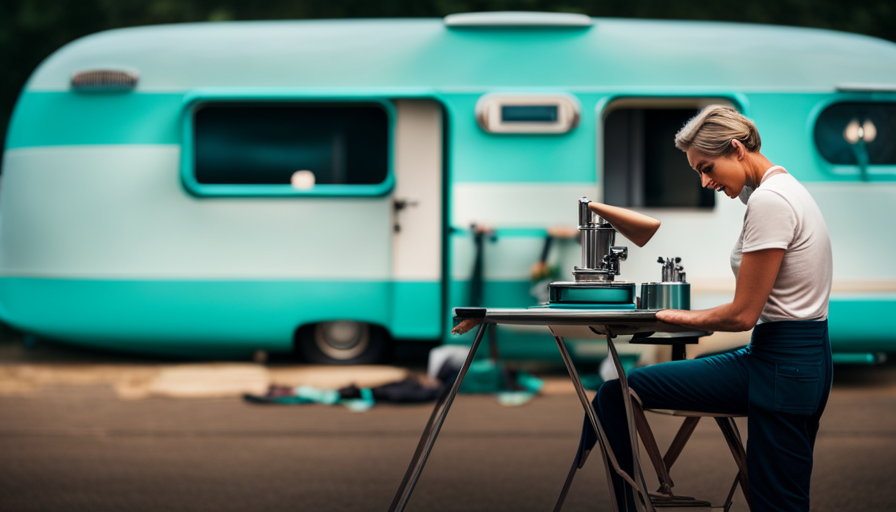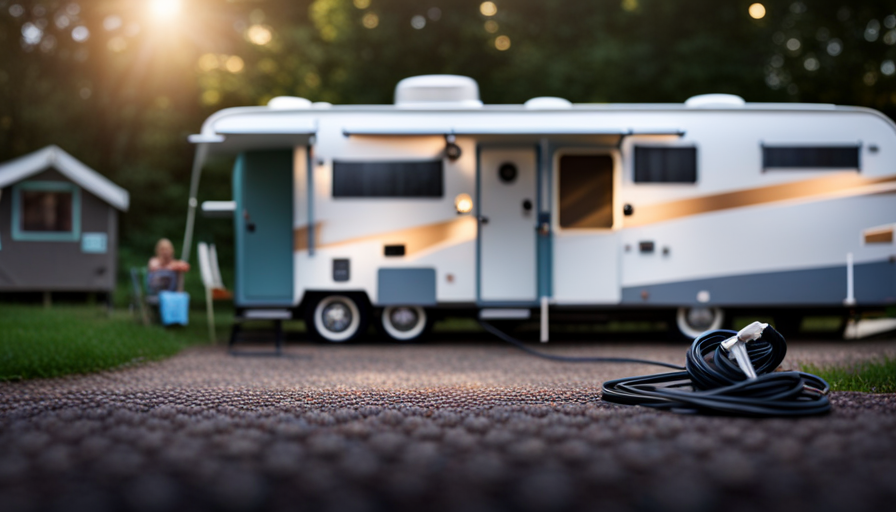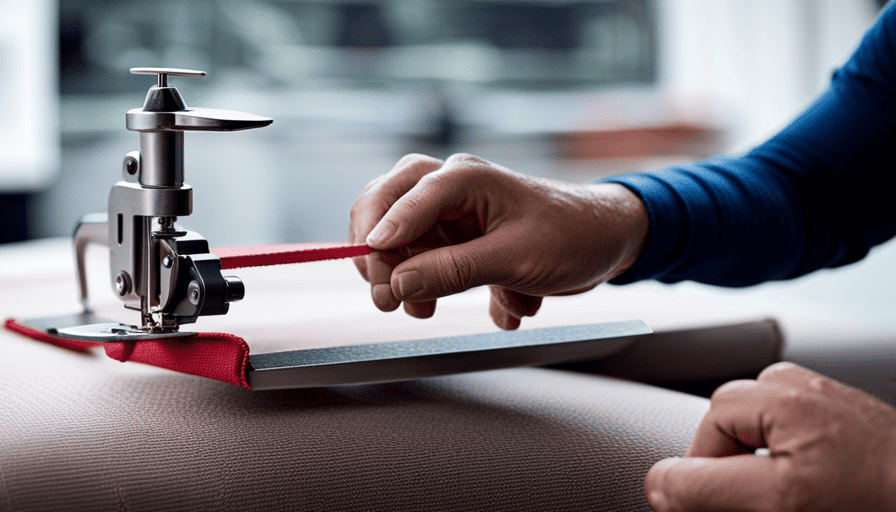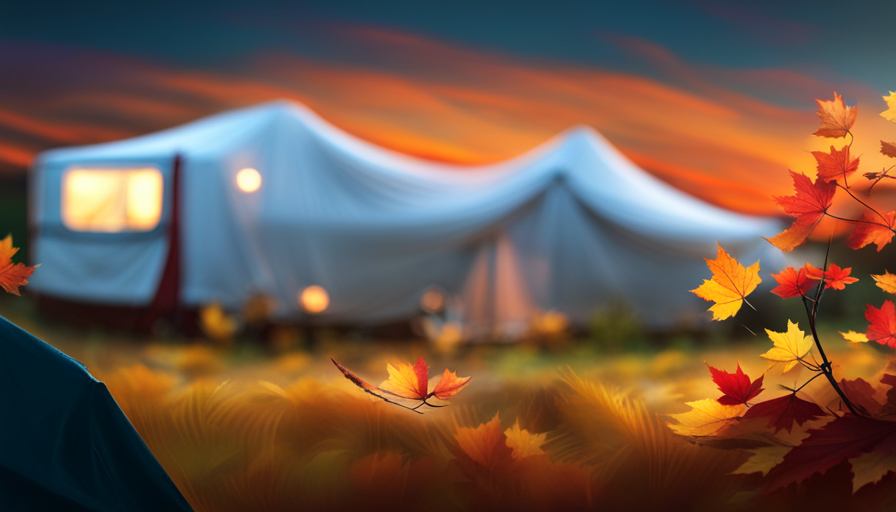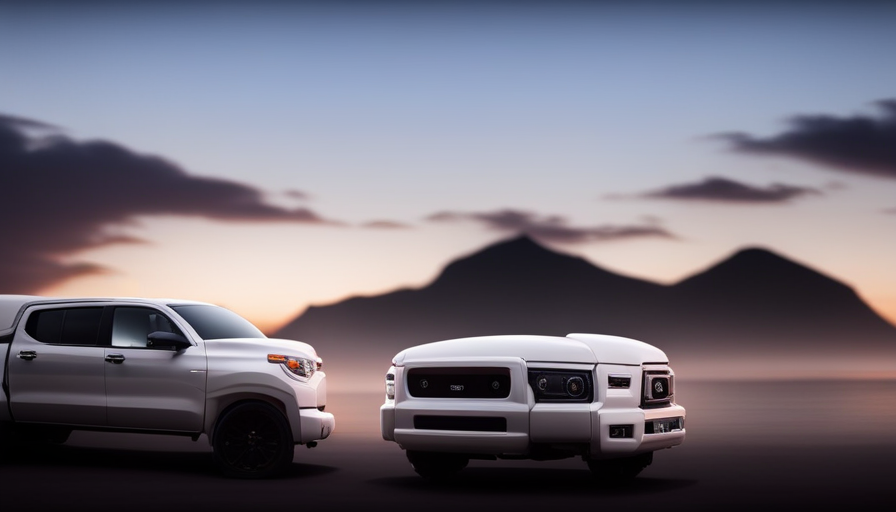Painting the outside of your RV is akin to breathing fresh life into it. Just as an artist wields a brush to turn a blank canvas into a masterpiece, you too can turn your camper into a piece of art.
In this article, I will guide you through the process of painting your camper’s exterior, step by step.
First, we will assess the condition of your camper’s exterior to determine if any repairs are needed. Then, we will clean and prep the surface to ensure a smooth and long-lasting finish.
Choosing the right paint and tools is crucial, as it will determine the durability and appearance of your camper’s new look.
Next, we will protect and mask off areas that you don’t want to be painted. Applying the base coat is where the magic happens, and additional coats may be needed to achieve the desired color and coverage.
Once the painting is complete, we will clean up and dispose of materials properly.
Finally, we will inspect for any imperfections and touch up as needed. When all is said and done, you can step back and admire your newly painted camper exterior, knowing that you have added your personal touch and revived its beauty.
So, let’s get started on this exciting journey of camper transformation!
Key Takeaways
- Assess the condition of the camper’s exterior before painting
- Prepare the surface before painting
- Choose the right paint type and color for outdoor use
- Apply multiple thin coats of paint
Assess the Condition of Your Camper’s Exterior
Now, take a good look at your camper’s exterior and see if it’s in shipshape condition before you dive into the exciting world of painting. Start by assessing the paint quality. Look for any signs of fading, peeling, or cracking. These are indicators that the paint is damaged and needs to be addressed before painting.
Additionally, check for any areas of damage such as dents, scratches, or rust. These will need to be repaired before you can proceed with painting. Identifying the areas of damage is crucial because they’ll require special attention. Dents and scratches can be smoothed out with sandpaper or filled in with body filler. Rust spots should be treated with a rust converter and primer to prevent further corrosion. By addressing these issues before painting, you’ll ensure a smooth and long-lasting finish.
Once you’ve assessed the condition of your camper’s exterior and made any necessary repairs, you can move on to the next step: cleaning and prepping the surface. This involves removing any dirt, grime, or old wax that may be present. A clean and properly prepped surface will allow the paint to adhere better and result in a professional-looking finish.
Clean and Prep the Surface
Before you begin, make sure to thoroughly clean and prepare the surface for a flawless transformation. Surface preparation is crucial to achieving a professional-looking paint job on your camper’s exterior.
Start by washing the surface with a mild detergent and water to remove dirt, grime, and any loose paint. Use a scrub brush or sponge to scrub away stubborn stains. Rinse the surface thoroughly and allow it to dry completely before proceeding.
Once the surface is clean, it’s important to properly prepare it for painting. Use a fine-grit sandpaper to lightly sand the entire surface. This will help remove any remaining loose paint and create a smooth surface for the new paint to adhere to. After sanding, wipe down the surface with a tack cloth to remove any dust or debris.
In addition to cleaning and sanding, consider using a primer before applying the paint. A primer will help the new paint bond to the surface and provide better coverage. Choose a primer that is specifically formulated for use on the material your camper is made of.
Now that the surface is clean and prepped, you can move on to choosing the right paint and tools for your camper’s exterior. [Transition sentence into the next section about choosing the right paint and tools.]
Choose the Right Paint and Tools
When it comes to painting the exterior of a camper, it’s important to choose the right paint type and color. I always make sure to select a paint that is specifically designed for outdoor use and can withstand the elements.
Additionally, considering the color is crucial as it can greatly impact the overall appearance of the camper.
Once I have chosen the paint, I gather all the necessary painting supplies such as brushes, rollers, paint trays, and drop cloths to ensure a smooth and efficient painting process.
Select a Paint Type and Color
Once you’ve decided on the paint type and color, how can you ensure it’ll withstand different weather conditions?
Choosing the right paint for your camper exterior is crucial in ensuring its durability. Look for paint that’s specifically designed for outdoor use and can withstand the elements. Acrylic latex paint is a popular choice as it’s flexible, long-lasting, and resistant to cracking and peeling. It also offers good coverage and is easy to clean.
When selecting the perfect color for your camper, consider both aesthetic preferences and practicality. Lighter colors tend to reflect sunlight and heat, which can help keep the interior cooler. Darker colors, on the other hand, may show dirt and scratches more easily.
Once you’ve chosen your paint type and color, gather the necessary painting supplies to begin the transformation.
Gather the Necessary Painting Supplies
To gather the necessary painting supplies for your camper transformation, make sure you have everything you need to bring your vision to life. Start by choosing the right paint color that suits your style and preferences. Consider the overall aesthetic you want to achieve and select a color that complements it.
Once you’ve decided on the paint color, it’s time to gather the supplies. You’ll need paint brushes, rollers, paint trays, drop cloths, painter’s tape, sandpaper, and a primer if necessary. These tools will ensure a smooth paint application and help you achieve professional-looking results.
Remember to clean and prepare the surfaces before painting for better adhesion.
With all your supplies ready, you can now move on to the next step of protecting and masking off areas before painting.
Protect and Mask Off Areas
When it comes to protecting and masking off areas before painting the camper exterior, there are a few key points to keep in mind.
First, it’s important to cover windows, lights, and trim to prevent any paint from getting on these areas. This can be done using plastic or paper coverings.
Additionally, using tape and plastic sheeting to protect adjacent surfaces is crucial in order to avoid any overspray or accidental paint splatters.
Cover Windows, Lights, and Trim
As you’re painting the exterior of your camper, don’t forget to protect the windows, lights, and trim to ensure they remain unharmed. Proper maintenance of these areas is crucial to maintaining the overall appearance and functionality of your camper. Here are some discussion ideas to consider:
-
Importance of proper window and trim maintenance: Regularly cleaning and inspecting windows and trim can prevent damage and prolong their lifespan. It also helps in maintaining a sleek and polished look for your camper.
-
Tips for choosing the right paint color for your camper’s exterior: Consider the overall aesthetic of your camper, as well as the environment it will be used in. Lighter colors can help reflect heat, while darker colors may show less dirt.
Remember, protecting adjacent surfaces is equally important. In the next section, we’ll discuss how to use tape and plastic sheeting to safeguard surrounding areas.
Use Tape and Plastic Sheeting to Protect Adjacent Surfaces
Start by carefully taping and covering nearby surfaces with plastic sheeting to ensure that no stray paint ends up where it doesn’t belong. This step is crucial to protect windows, lights, and trim from accidental paint splatters or drips.
If you don’t have tape or plastic sheeting, you can use painter’s paper or drop cloths as alternatives.
When it’s time to remove the tape and plastic sheeting, do it slowly and at a 45-degree angle to avoid peeling off any paint. Use a sharp utility knife to score along the edges of the tape before pulling it off. For plastic sheeting, gently remove it by pulling it away from the surface.
With all the adjacent surfaces properly protected, you can now move on to applying the base coat of paint.
Apply the Base Coat
To achieve a vibrant and eye-catching camper exterior, it’s time to brush on the first coat of paint. Here are some tips and techniques to ensure a smooth and professional-looking finish:
-
Clean the surface: Before applying the base coat, make sure to thoroughly clean the camper exterior. Remove any dirt, grime, or loose paint using a mild detergent and a scrub brush. Rinse it off with clean water and let it dry completely.
-
Use a primer: Applying a primer before the base coat helps the paint adhere better and provides a uniform surface. Choose a primer that’s specifically designed for the type of paint you’ll be using and apply it evenly using a brush or a roller.
-
Choose the right paint: Select a high-quality exterior paint that’s suitable for outdoor use. Look for paint that’s durable, fade-resistant, and weatherproof.
-
Apply thin coats: It’s better to apply multiple thin coats of paint rather than one thick coat. This helps prevent drips, streaks, and uneven coverage. Use a brush or a roller to apply the paint in smooth, even strokes.
-
Allow for drying time: Once the base coat is applied, let it dry according to the manufacturer’s instructions. This usually takes a few hours or overnight. Avoid touching or disturbing the paint during this time.
Now that the base coat’s applied, it’s important to let it dry completely before moving on to the next step.
Let the Base Coat Dry
Allow yourself to patiently wait for the base coat to fully dry, as this crucial step will bring you one step closer to the stunning transformation you’ve been dreaming of. Letting the base coat dry completely is essential for achieving a smooth and flawless finish on your camper’s exterior. Here are some tips to ensure a successful drying process and common mistakes to avoid:
Tips for a smooth finish:
- Find a well-ventilated area: Choose a location where your camper can dry undisturbed for the recommended drying time.
- Follow manufacturer’s instructions: Different base coat products may have varying drying times, so be sure to read and follow the instructions provided.
- Avoid touching or moving the camper: Disturbing the drying base coat can lead to imperfections and uneven coverage.
- Check for dryness: Gently touch a small inconspicuous area to ensure the base coat is completely dry before proceeding.
Common mistakes to avoid:
- Rushing the drying process: Patience is key. Allowing the base coat to dry thoroughly will prevent issues such as wrinkling or peeling.
- Applying additional coats too soon: Wait until the base coat is fully dry before applying any additional coats to avoid compromising the finish.
By following these tips and avoiding common mistakes, you’ll ensure a smooth and flawless base coat. Once the base coat is dry, you can move on to the next step of applying additional coats if needed.
Apply Additional Coats if Needed
After letting the base coat dry, it’s time to assess if additional coats are needed. Sometimes one coat is enough, but other times you may want to apply multiple coats to achieve the desired finish. When deciding whether to apply more coats, it’s important to consider the coverage and any imperfections that may still be visible.
To apply additional coats, start by allowing each coat to dry completely before moving on to the next. This ensures that the paint adheres properly and prevents any smudging or unevenness. The drying time can vary depending on the type of paint you’re using, so be sure to follow the manufacturer’s instructions.
When applying the subsequent coats, use the same technique as before, whether it’s rolling, brushing, or spraying. Make sure to apply a thin, even coat to avoid drips or streaks.
As you apply each coat, take the time to inspect the surface for any areas that may need touch-ups or additional coverage. This’ll help you achieve a smooth and professional finish.
Once you’re satisfied with the number of coats applied and the drying time has passed, it’s time to move on to the next step: cleaning up and disposing of materials properly.
Clean Up and Dispose of Materials Properly
Once you’re satisfied with the finished result, it’s crucial to properly clean up and dispose of all materials used during the painting process.
To start, gather all the paint cans and check if there’s any leftover paint. If there is, make sure to dispose of it properly. You can either seal the cans tightly and store them for future touch-ups or take them to a hazardous waste facility for safe disposal.
Next, it’s important to clean up your paint brushes. Fill a bucket with warm soapy water and thoroughly clean the brushes, making sure to remove all traces of paint. Rinse them well and let them air dry. Once the brushes are clean, you can store them properly for future use.
Remember, it’s essential to dispose of paint cans and clean up paint brushes correctly to avoid any environmental harm.
With the materials properly cleaned up and disposed of, you can now move on to the next step of inspecting and touching up any imperfections in your newly painted camper.
Inspect and Touch Up Any Imperfections
Take a close look at your work and carefully examine for any areas that may require touch-ups or imperfections that need addressing, ensuring a flawless finish.
Inspecting your camper exterior is an essential step in the painting process. Look for any small scratches, chips, or areas where the paint may not have adhered properly.
Once you have identified these imperfections, it’s time to touch them up. There are various touch-up techniques you can use, depending on the size and severity of the imperfections.
For small scratches and chips, you can use touch-up paint pens or brushes. These tools allow for precise application and blend in seamlessly with the surrounding paint.
When choosing the right touch-up paint, make sure to match the color and finish of your existing paint as closely as possible. This will help achieve a cohesive and professional-looking result.
Once you have addressed all the imperfections, step back and admire your newly painted camper exterior!
Admire Your Newly Painted Camper Exterior!
After inspecting and touching up any imperfections on your camper’s exterior, it’s time to step back and admire your hard work! Standing in front of your newly painted camper, you can’t help but feel a sense of accomplishment.
The transformation is incredible, and you can’t wait to share your achievement with others. To celebrate this moment, why not take some before and after photos? These pictures will not only serve as a reminder of the hard work you put into this project but also inspire others who are considering painting their own campers.
Seeing the dramatic change side by side will showcase the power of a fresh coat of paint. In the before photos, you can capture the worn-out exterior, highlighting the imperfections that you’ve diligently addressed. Then, in the after photos, show off the camper’s vibrant new look, demonstrating the difference your efforts have made.
Sharing these photos with friends, family, and fellow campers will undoubtedly spark conversations and inspire others to take on similar projects. So, grab your camera or smartphone, capture the beauty of your newly painted camper, and proudly share your before and after photos with the world!
Frequently Asked Questions
How long does the base coat need to dry before applying additional coats?
The drying time of the base coat before applying additional coats can vary depending on the specific paint product you’re using. It’s important to follow the manufacturer’s instructions for the recommended drying time. Typically, it can take anywhere from a few hours to overnight for the base coat to dry completely. Make sure to allow sufficient drying time to ensure a smooth and durable finish for your camper exterior.
What types of imperfections should I be looking for when inspecting the painted camper exterior?
When inspecting the painted camper exterior, I look for various types of paint imperfections. These can include runs, drips, sags, orange peel texture, or uneven coverage.
To fix these imperfections, I first identify the issue and its cause. Then, I sand down the affected area, apply a primer if necessary, and repaint. It’s important to ensure a smooth and even finish by using proper techniques and high-quality materials.
Can I use regular household paint for my camper’s exterior, or do I need a specific type of paint?
Regular household paint isn’t recommended for painting a camper’s exterior because it may not withstand the harsh conditions and constant exposure to the elements. Instead, it’s best to use a specific type of paint designed for outdoor use. When it comes to painting techniques, make sure to prepare the surface properly, apply primer, and use a high-quality paint brand. Some popular paint brands for camper exteriors include Rust-Oleum, Valspar, and Behr.
What safety precautions should I take when cleaning up and disposing of painting materials?
When cleaning up and disposing of painting materials, it’s important to take safety precautions.
First, wear protective gloves and a mask to avoid direct contact with chemicals and fumes.
Use a drop cloth or tarp to collect any spills or drips.
Avoid pouring paint down drains or throwing away in regular trash. Instead, let leftover paint dry out before disposing of it properly.
Remember to follow local regulations for hazardous waste disposal to protect the environment.
Can I paint over existing decals and graphics on my camper’s exterior, or do they need to be removed first?
When it comes to painting over decals on your camper’s exterior, it’s important to consider a few things. While it’s possible to paint over existing decals, it’s generally recommended to remove them first for better adhesion and a smoother finish. Removing decals can be done using heat or adhesive removers. Once the decals are removed, you can proceed with prepping and painting the camper’s exterior for a fresh new look.
Are the Steps to Paint a Fiberglass Camper Shell the Same as Painting the Exterior of a Camper?
When it comes to painting a fiberglass camper shell, the steps are slightly different compared to painting the exterior of a camper. The fiberglass shell requires special attention, including thorough cleaning, sanding any imperfections, and applying a primer specifically designed for fiberglass. Following these steps ensures a smooth and long-lasting finish for the camper shell’s exterior.
Conclusion
Well, after spending some time painting the exterior of my camper, I must say that it was well worth the effort.
The theory that a fresh coat of paint can completely transform the look of a camper is absolutely true! Not only does it give the camper a new lease on life, but it also adds a personal touch and makes it stand out from the crowd.
So if you’re considering painting your camper, don’t hesitate. Just follow the steps, choose the right paint, and enjoy the amazing results!

